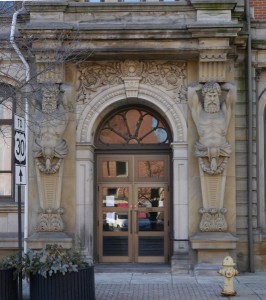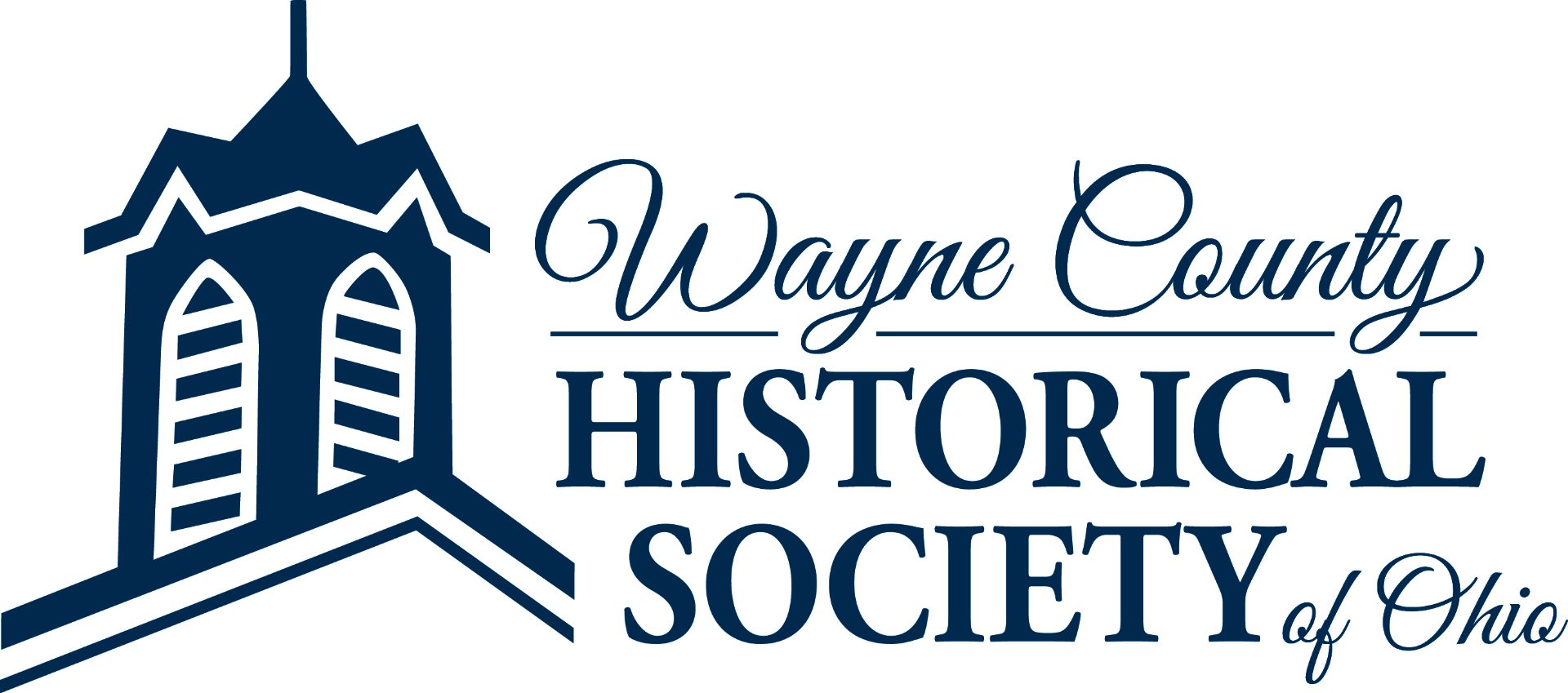
It has previously been speculated that unnamed itinerant Italian stonemasons carved the four exquisite stone telamones, or Atlases, that adorn the Wayne County Courthouse in Wooster, Ohio.
However, there is another theory to present after finding an article in the Wayne County Democrat newspaper about the ongoing construction of the courthouse in 1878. The news story dated December 18, 1878 on page 3 stated:
Contractor Keyser is pushing the stone cutting of the new Court House right along in the shed in front of the County Buildings, at present working on the columns for second story, and proposes to have all ready for laying the first of March. Two of the four caryatids, or Hercules, are nearly finished. These are double life size figures, cut from Berea stone, to be placed at either side of the doorways, supporting the cornice. They are carved by Mr. Rachlay (RACKLE), formerly of Baden, and Mr. Shildmacher (SCHILDMACHER), of Rhine, Prussia, whose work show them to be artistic sculptors, their skill being much admired by all who have seen the giant figures, which are worth beholding.

Granted there were a few mistakes in this report: the writer accidentally used the wrong architectural terminology for the sculpted figures by stating they were caryatids instead of telamones. A caryatid refers to a sculpted female figure serving as an architectural support column, while a telamon is commonly the term used for a sculpted male figure support column. Plus, Hercules was not typically the Greek God often referenced for holding the weight of the world on his shoulders, that was Atlas, the last of the Titans. Therefore, it might not be surprising that the writer might have also misspelled the names of the artists that carved our wonderful Atlases.

Finding a copy of the book, Artists in Ohio, 1787-1900: A Biographical Dictionary, compiled and edited by Mary Sayre Haverstock, Jeannette Mahoney Vance, Brian L. Meggitt revealed that there were two artists by the names of George Rackle [Rachle] and Henry Schildmacher working in northern Ohio as sculptors during the time period our courthouse was being built in 1878-1879. On page 701 it is revealed that George Rackle was an esteemed sculptor in his time and had other notable works:
Rackle [Rachle], George (1837-1909). Carver and sculptor in wood, stone, and composite materials, born in Baden, Germany, and active in Columbus (Franklin) from 1867 to 1871 as a partner in the marble works of Rackle, Zimmerman, and Company. A former pupil of the Munich Academy, he later moved to Cleveland (Cuyahoga), where he executed a number of public and private commissions between 1874 and his retirement in 1900, most notably a Portland cement centaur-and-dolphin fountain erected in Wade Park in 1885 and a pair of nymph-and-dolphin fountains for Woodland Cemetery, commissioned in 1887….
On page 758 a short biography of Henry Schildmacher is given:
Schildmacher, Henry. Sculptor, born in Prussia about 1845 and active in Cleveland (Cuyahoga) by 1879. For a year or two, he worked with a sculptor named HOERSTMANN at 676 Superior Street, but in 1900, he was associated with JACOB STEPHAN. Together they designed a group of allegorical figures for the Pan-American Exposition, held in Buffalo the following year. He may have been the same Henry Schildmacher (1847-1913) listed in the records of Calvary Cemetery, Cleveland….
The short biographies found in the book seem to support that the Mr. Rachlay and Mr. Shildmacher named in our local newspaper may have in fact been the artists George Rackle and Henry Schildmacher. It is hard to say if the two sculptors worked together on carving all four figures, or if they split the work between them, with one working on one set and one working on the other set. Personally, i think they might have split the work. To me there is a marked difference between the set of Atlases that face Liberty St. and the set that face onto Market St. The figures on Liberty St. seem smaller and the base uncomplicated, while the set of Atlases on Market St. look bigger and the base is more intricately adorned with flourishes. If I had to put money on who sculpted which set of Atlases, my money would go on Schildmacher for the Liberty St. figures and Rackle for the Market St. telamones. Furthermore, I had once heard the Ladies of Justice sitting near the top of the courthouse were carved out wood which leads me to speculate that George Rackle also carved those fine figures as he was known to work in that medium too. Of course that’s just my humble opinion and maybe someday an art expert will come to town and be able to tell us more about all the fine works of art on the Courthouse.
You might be wondering how much weight those Atlases are holding up? The Wayne County Democrat newspaper dated November 6, 1878 on page 3 gives us the answer:
The biggest block of stone yet received, and the largest that will be laid in the Court House, came last Wednesday from the Berea quarry, being eighteen feet long, five wide and two thick, weighing nearly fourteen tons. Sam Betson’s six-horse team hauled it from the depot on two wagons lashed together, but when opposite the American Hotel a wheel broke down and stopped further advance until next afternoon, affording all a sight of the big stone in the middle of the street. Another of the same size is to be received. They form the cornice over the Atlas figures above the east and south doorways, twenty-one feet above the pavement, and will be put in place in about a month.


Wayne County may hold one of the few remaining artistic sculptures of George Rackle as his renowned Cleveland area fountains no longer exist. Next time you are in downtown Wooster, take a moment to appreciate the fine telamon sculptures that adorn the Wayne County Courthouse as was said in 1878, “are worth beholding.”

One Reply to “Who Really Carved the Wa. Co. Courthouse Atlases”
Comments are closed.